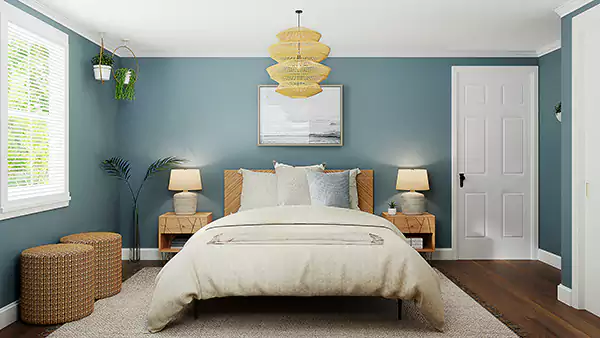How to Make the Most of a Small Bedroom
Although a small bedroom may present challenges, you should do what you can to optimize the space. Creating storage solutions, promoting tranquility, and encouraging resourcefulness are all essential components of making the most out of a small bedroom. By applying these principles, you can transform your small space into a functional, peaceful, and aesthetically pleasing haven that meets your needs and enhances your overall well-being. In this article, discover how to make the most of your small bedroom and turn it into the comfortable and stylish sanctuary you deserve.
Selecting Your Bedroom Furniture

Choosing the right furniture for a small bedroom can be a daunting task, especially when aiming to maintain a balance between functionality and aesthetics. When selecting furniture, pay attention to its scale and how it communicates with the room. Remember, your bedroom furniture should serve its purpose without overwhelming the space. Choosing the correct bed size is also a priority. In a small room, the bed often takes up most of the space. A large bed may offer comfort, but it can make your room seem excessively cramped. Your bed selection should find a balance between comfort and space optimization.
Dressing your bed with duvet covers can also add character and style to your bedroom without taking up additional space. A duvet cover is more than just a practical bedding item; it adds a touch of style and elegance to any bedroom. With its versatile design and wide range of options available, a duvet cover allows you to enhance the look and feel of your space effortlessly. Whether you prefer a minimalist and clean aesthetic or a bold and vibrant design, there is a duvet cover to suit every taste and bedroom decor. This makes it an incredibly cost-effective option for those who have a limited budget for interior design.
Beyond that, horizontal furniture, like a low-lying bed frame, can make your ceiling seem taller and your room feels more spacious. Additionally, multifunctional furniture like beds with built-in storage can provide an excellent solution for housing your items without eating up extra space. You may even want to consider investing in furniture with reflective surfaces or mirrored finishes. These pieces can reflect light, making your room brighter and theoretically bigger.
Understand Your Space
If you aim to enhance your small bedroom, the first approach is understanding the space you’re working with. This involves more than merely understanding its square footage. It means discerning architectural quirks, and ceiling heights, and determining which walls are load-bearing. You must also consider the position of your windows and the natural light that comes into your room Understanding these aspects will determine the placement of your furniture, curtains, and decorative items, ensuring that each complements the other and does not overwhelm the already limited space.
Also, before embarking on your bedroom decoration and arrangement, it’s crucial to declutter your space. A clutter-free room appears bigger and is more comfortable to decorate. During the decluttering process, only keep items that are useful and meaningful. Dispose of everything else, as it only contributes to making your place look crowded and uninviting.
In order to determine the best design plan for your room, you should take into consideration your lifestyle and preferences. For individuals who love reading before sleep, for instance, you might want to incorporate a small reading nook despite the room’s size. If you work from home, a compact, floating desk near the window might be a great addition. Whilst optimizing a small bedroom requires clever planning and organizing, your comfort needs should not be overlooked.
Choosing the Right Colors
Color plays a significant role in setting the mood and appearance of a space. For small bedrooms, light colors can create an illusion of more space. Soft tones like white, cream, and pastel colors reflect light and can make your room feel airy and spacious. However, don’t shy away from embracing dark colors. When utilized properly, they can add depth and character to your space, making it cozy and comforting.
Patterned wallpaper can also work well in small bedrooms. However, you need to choose designs that don’t overwhelm the space. Small and simple patterns often work best in such settings. Using mirrors and glass can bounce light around the room, enhancing the feel of openness. Think about the effect of your flooring choice on the room’s feel. Light-colored carpets and flooring can help to elongate the sense of room space.
Optimizing Storage Space
Storage is often a challenge in small bedrooms. But with a bit of creativity, you can maximize storage and minimize clutter. Consider multifunctional furniture with storage spaces, installing floating shelves, or utilizing boxes that fit under your bed. Your closet is also a potential goldmine for storage. Use clothes organizers to maximize your closet space, and consider adding a high shelf for rarely-used items.
The goal is to maximize the capacity without visual clutter. Look for storage solutions that enhance tidy organization and maintain the room’s attractiveness. A common strategy is to use one big storage item, like a wardrobe or armoire, instead of several small pieces. This creates a cleaner visual line and a more spacious look. Don’t forget the magic of hooks – these ingenious inventions can get items off your floor, thereby freeing up more space. You can use hooks for hanging anything from coats and bags to jewelry and keys.
Incorporating Design Elements

As you optimize your bedroom, be sure not to strip it of style and personality. Incorporate design elements that will add life to your bedroom. Start with your walls. Even when painted a single color, you can bring in paintings, wall hangings, or even a tapestry to give some life to your space. Moderation is key. Don’t overdo it with wall art as this can easily make your room look cluttered and smaller.
Lighting is another key factor in any room. Apart from illuminating your room, the right choice of lighting can also serve as an attractive decor feature. Layered lighting is a good idea, with task lamps for reading, low pendant lights for a cozy ambiance, and bright overhead lights for general illumination. Combine functionality with aesthetics by choosing statement lamps or lights with interesting designs. Whenever purchasing home decor, don’t forget to shop at a trusted retailer that sells quality products.
Maintaining a Clean and Organized Bedroom

A clean and organized bedroom is required, particularly for a small room where every piece of space counts. It begins with daily tidying practices, such as making your bed every morning and promptly putting away items after use. Strive to keep your surfaces as clear as possible, only leaving necessities such as a bedside lamp, a clock, or a glass of water. Invest in a regular deep-clean routine to keep your bedroom healthy and pleasant.
This will involve washing your sheets and covers regularly, dusting, and vacuuming. Part of this routine should also include decluttering to get rid of items that you don’t need. The cleaner and less cluttered your room is, the larger it will feel.
Creating and maintaining a clean and organized bedroom should not be a daunting task. Rather, it should become a habit that you enjoy doing. This way, your bedroom remains an inviting sanctuary that you are proud of, no matter how small it may be.
Your bedroom doesn’t have to be a cause of stress. By selecting the appropriate furniture, making smart use of color and lighting, and using storage solutions, you can make your bedroom look spacious, functional, and stylish. The most important factor is that you feel comfortable in your space. Therefore, while you strive to create space, make sure your small bedroom maintains its character and feels like home to you. A small space pushes you to be creative, organized, and conscious about what you bring into your room. With these tips, you can transform your small bedroom into a cozy sanctuary full of style and personality.
Follow Us
Latest Post















